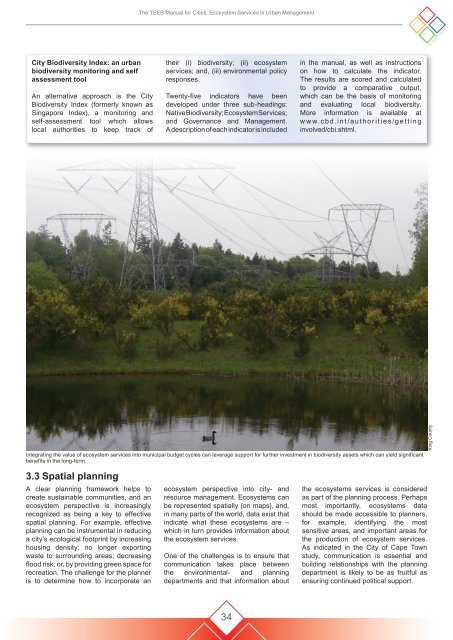TEEB Manual for Cities
TEEB Manual for Cities
TEEB Manual for Cities
You also want an ePaper? Increase the reach of your titles
YUMPU automatically turns print PDFs into web optimized ePapers that Google loves.
The <strong>TEEB</strong> <strong>Manual</strong> <strong>for</strong> <strong>Cities</strong>: Ecosystem Services in Urban ManagementCity Biodiversity Index: an urbanbiodiversity monitoring and selfassessment toolAn alternative approach is the CityBiodiversity Index (<strong>for</strong>merly known asSingapore Index), a monitoring andself-assessment tool which allowslocal authorities to keep track oftheir (i) biodiversity; (ii) ecosystemservices; and, (iii) environmental policyresponses.Twenty-five indicators have beendeveloped under three sub-headings:Native Biodiversity; Ecosystem Services;and Governance and Management.A description of each indicator is includedin the manual, as well as instructionson how to calculate the indicator.The results are scored and calculatedto provide a comparative output,which can be the basis of monitoringand evaluating local biodiversity.More in<strong>for</strong>mation is available atwww.cbd.int/authorities/gettinginvolved/cbi.shtml.Integrating the value of ecosystem services into municipal budget cycles can leverage support <strong>for</strong> further investment in biodiversity assets which can yield significantbenefits in the long-term.3.3 Spatial planningA clear planning framework helps tocreate sustainable communities, and anecosystem perspective is increasinglyrecognized as being a key to effectivespatial planning. For example, effectiveplanning can be instrumental in reducinga city’s ecological footprint by increasinghousing density; no longer exportingwaste to surrounding areas; decreasingflood risk; or, by providing green space <strong>for</strong>recreation. The challenge <strong>for</strong> the planneris to determine how to incorporate anecosystem perspective into city- andresource management. Ecosystems canbe represented spatially (on maps), and,in many parts of the world, data exist thatindicate what these ecosystems are –which in turn provides in<strong>for</strong>mation aboutthe ecosystem services.One of the challenges is to ensure thatcommunication takes place betweenthe environmental- and planningdepartments and that in<strong>for</strong>mation aboutthe ecosystems services is consideredas part of the planning process. Perhapsmost importantly, ecosystems datashould be made accessible to planners,<strong>for</strong> example, identifying the mostsensitive areas, and important areas <strong>for</strong>the production of ecosystem services.As indicated in the City of Cape Townstudy, communication is essential andbuilding relationships with the planningdepartment is likely to be as fruitful asensuring continued political support.King County34
















